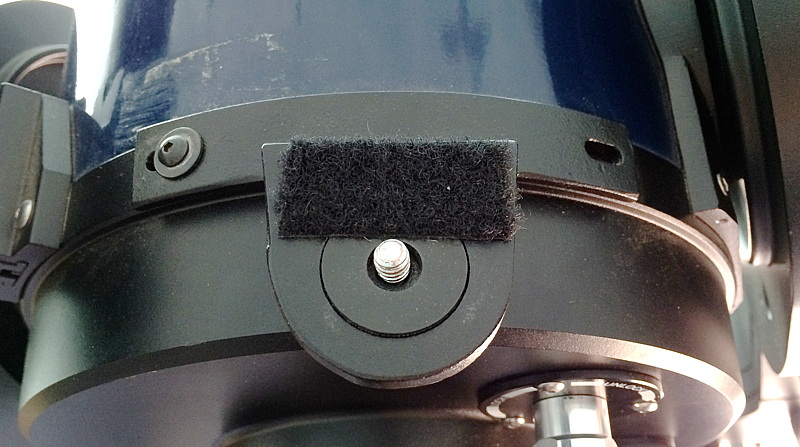
Piggyback Adapter mod, Jupiter & Moon,
NGC2336 Galaxy, Crater Copernicus
Posted: 11 February 2014
On my previous report, I mentioned a problem with the Meade Piggyback Camera Adapter when used with a long lens at some telescope orientations. The adapter would not sufficiently "grip" the DSLR base to prevent slippage. I briefly searched the Internet for an alternative adapter but did not find one I liked. So I decided to see what could be done with my adapter to provide a better grip on the camera base. The simplest solution was to add a piece of the soft side of a Velcro strip to the adapter:

Initial tests indicated that it might hold the camera more securely and prevent slippage. Will try it.
Also, notice that there is only one screw holding the Meade Piggyback Camera Adapter on the optical tube assembly (OTA). The holes do not match the existing screws on the 8" LX200-ACF model. They did match on my old LXD75-8"SC OTA (which was stolen in 2007). The adapter is still held securely to the OTA by the single screw. A second screw is hidden beneath the adapter; its screwhead fits in a depression in the adapter base plate and keeps the adapter from shifting when the other screw is tight.
|
Opened: Monday, 10 February 2014, 1815 MST Temperature: 67°F |
Session: 653 Conditions: Mostly clear with clouds in west |
1822 MST: viewed Jupiter, 83X. Seeing bad. The four Galilean Moons were visible. Both the North Equatorial Belt (NEB) and the South Equatorial Belt (SEB) seemed thinner this night than on recent nights, especially the SEB. Tried 222X but the view was too "fuzzy" due to poor seeing.
Jupiter was about 5° from the waxing gibbous moon this night. Took this photo (cropped) with the D7000 DSLR, f/11, 1/250sec, ISO 400, 230mm, at 1828 MST:

1830 MST: viewed the moon, 222X and then 83X. This handheld afocal 83X photo was taken at 1838 MST with the iPhone 5s:

At 1844 MST, took this iPhone 5s photo of the sky showing Jupiter, the moon, and Sirius:

Mouseover or tap to see labels
Not bad for a smartphone photo!
1855 MST: resumed Jupiter observing, 83X. Seeing seemed to be a little better now. Tried some Jupiter eyepiece projection 222X imaging with the D7000 DSLR. Mounted the camera on the 8" LX200-ACF and did a focus test on Betelgeuse with the Bahtinov Mask. Then did several 15 second HD video recordings of Jupiter, 222X, at various shutter speeds and ISO settings. This image is a stack of 236 frames taken at 1/60sec, ISO 2500:

1915 MST: back to Jupiter observing, 222X. Seeing was a little better with some nice views during moments of steady seeing.
1918 MST: viewed the M82 galaxy, 83X. Supernova SN2014j still easily seen even with bright moonlit sky. Decided to try piggyback photography of M82 with my "fixed" piggyback camera adapter. Unfortunately, the camera still rotated on the adapter during exposures due to the weight of the camera lens and orientation of the telescope. Will have to come up with a different modification.
1945 MST: tried to view NGC2336, a circumpolar galaxy (Declination +80°10', Magnitude +10.39), using 83X. However, the sky was too bright due to the bright moon to see the galaxy. Decided to try imaging it anyway. Mounted the D7000 DSLR at 8" prime focus using the off-axis guider. Did a focus test with the Bahtinov Mask on Pollux. At 1958 MST, with some clouds in the northern sky, turned on High Precision on the telescope and slewed to NGC2336. Centered the alignment star in the camera viewfinder and did an unguided 1 minute, ISO 6400, framing test exposure. Could not find a guide star (due to the bright sky). Did unguided 2 and 3 minute exposures. This is a stack of the 1 and 2 minute exposures of NGC2336:

Part of the spiral arms are barely visible. Should be able to get a better image once the moon is not a factor.
Ended imaging. 2025 MST: clouds in southwestern sky now. Viewed Rigel and its companion star, 222X. Then slewed to Sirius to try for Sirius B using the bright sky to reduce the glare from Sirius A. Tried to see the "Pup Star", 222X, but was unsuccessful this night. (I have seen it in the past with the 8" telescope so I know it is possible to view it.)
2033 MST: back to Jupiter. Seeing still not very good. Clouds were now in more of the sky.
Viewed the moon, 222X. Took this handheld iPhone 5s photo (cropped) of the crater Copernicus, afocal 222X, at 2037 MST, and shows the crater and the surrounding ray pattern:

|
Closed: Monday, 10 February 2014, 2051 MST Temperature: 53°F |
|
Comments are welcome using Email. Thanks.
Cassiopeia Observatory Home Page